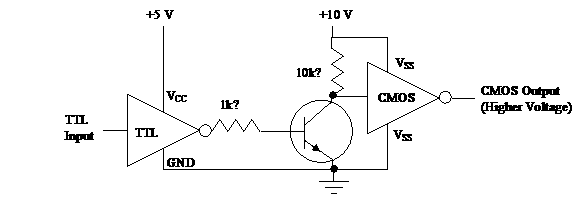The following figures demonstrate how to interface a TTL signal to a CMOS circuit and a CMOS circuit to a TTL input. The figures also show how to interface the two circuits if the voltage levels are incompatible.

Figure 1: TTL-to-CMOS interfacing using pull-up resistor

Figure 2: CMOS-to-TTL interfacing using a CMOS buffer IC

Figure 3: TTL-to-CMOS interfacing using a transistor

Figure 4: TTL-to-CMOS interfacing using a TLL open-collector buffer IC

Figure 5: CMOS-to-TTL interfacing using a CMOS buffer IC
(Roger L. Tokheim, Digital Electronics, 3d ed., McGraw-Hill, New York, 1990)